City in New York, United States
| North Tonawanda | |
|---|---|
| City | |
| City of North Tonawanda | |
   Left to right from top: Gateway Harbor, Herschell Carrousel Factory Museum, Riviera Theatre Left to right from top: Gateway Harbor, Herschell Carrousel Factory Museum, Riviera Theatre | |
 Flag Flag | |
| Nickname: N.T. | |
 Location in Niagara County and the state of New York. Location in Niagara County and the state of New York. | |
| Coordinates: 43°2′28″N 78°52′8″W / 43.04111°N 78.86889°W / 43.04111; -78.86889 | |
| Country | United States |
| State | New York |
| County | Niagara |
| Government | |
| • Type | Mayor-Council |
| • Mayor | Austin J. Tylec (D) |
| Area | |
| • Total | 10.89 sq mi (28.22 km) |
| • Land | 10.09 sq mi (26.14 km) |
| • Water | 0.80 sq mi (2.08 km) |
| Elevation | 574 ft (175 m) |
| Population | |
| • Total | 30,496 |
| • Density | 3,021.50/sq mi (1,166.62/km) |
| Time zone | UTC-5 (Eastern (EST)) |
| • Summer (DST) | UTC-4 (EDT) |
| ZIP code | 14120 |
| Area code | 716 |
| FIPS code | 36-53682 |
| GNIS feature ID | 0958935 |
| Website | City website |
North Tonawanda is a city in Niagara County, New York, United States. The population was 31,568 at the 2010 census. It is part of the Buffalo–Niagara Falls Metropolitan Statistical Area. The city is named after Tonawanda Creek, its south border.
Tonawanda in the Seneca language means "Swift Running Water". Tonawanda Creek, which flows into the Niagara River, once had large stretches of rapids (see Rapids, New York) until it was tamed with the construction of the Erie Canal.
The city also calls itself "The Lumber City," due to its past primary industry and once was the largest port on the Great Lakes during the height of the Erie Canal. Along Goundry Street are mansions built for the lumber barons, including 208 Goundry Street, called "Kent Place", designed by Stanford White. Many of the local residents refer to the city as "The Jewel of Niagara County" due to its geographical setting between the Niagara River and Erie Canal. Street signs on the borders of town welcome visitors to "The Home Of The Carousel".
History
After the first settlers arrived in 1809, North Tonawanda became part of the town of Wheatfield, New York in Niagara County, from May 1836. An abortive attempt at a village containing portions in two counties and two towns from January 1854 until April 1857, it was part of the Niagara County/Town of Wheatfield component, with the other portion in Erie County and the Town of Tonawanda. The experiment was abandoned after New York State removed the village's North Tonawanda component. Oral history claims a dispute between merchants was the cause, but the combination of communities in two counties and two towns was unwieldy. After becoming a village on May 8, 1865 (still in the Town of Wheatfield, but as part of Martinsville, New York), North Tonawanda was incorporated as a City on April 24, 1897.
North Tonawanda is on the north side of the Erie Canal/Tonawanda Creek, across from Erie County, New York and the communities of the City of Tonawanda and the Town of Amherst. The Town of Wheatfield borders North Tonawanda on the north and east; the Niagara River serves as its western border, as Tonawanda Creek is its southern border. North Tonawanda is the second largest city in Niagara County, after Niagara Falls, New York.
North Tonawanda is known as "The Lumber City," because it was from the mid-19th century through the 1970s, a lumber transportation and forwarding center of significance because of the ready availability of lumber. It was the birthplace of the Herschell-Spillman Company/Allan Herschell Co., one of the leading manufacturers of carousels in America and is now the home of the Herschell Carrousel Factory Museum. In 1888, Herschell attracted expatriate Belgian Eugene de Kleist to North Tonawanda, who started the North Tonawanda Barrel Organ Factory to produce band organs. Taken over in 1909 by the Rudolph Wurlitzer Company after De Kleist became mayor of North Tonawanda in 1906, Wurlitzer became one of the largest musical instrument manufacturing plants in the world. The Ray H. Bennett Lumber Co., one of more than 150 lumber companies to have called North Tonawanda home, produced kit homes sold around the nation and Canada for 70 years. Richardson Boat, Buffalo Bolt, Durez Chemical, National Grinding Wheel, Taylor Devices, International Paper, Tonawanda Iron & Steel, Riverside Chemical, and hundreds of other successful manufacturing businesses called North Tonawanda home.
The Railroad Museum of the Niagara Frontier occupies a 1923 Erie Railroad station on Oliver Street. The Riviera Theater and Performing Arts Center on Webster Street, in a restored Italian Renaissance-style building, features plays, concerts, movies and other events, and its 1926 "Mighty Wurlitzer" organ is featured in monthly organ concerts. The theater is one of only a handful in the United States with projectors capable of showing nitrate film prints in common use before about 1951. The Ghostlight Theatre is a community theater in a century-old church. The former Carnegie Library is home to the Carnegie Art Center. An E. B. Green designed building houses the Buffalo Suzuki Strings Musical Arts Center. An active arts community has developed in the downtown area as well. The North Tonawanda History Museum no longer occupies the former G. C. Murphy Co. store building on Webster Street in the heart of the Downtown Historic District.
Parks in North Tonawanda include Veteran's Park, which has a monument to U.S. Seabees, one to the U.S. Marines, and is working on one to Vietnam War Veterans; Gateway Harbor Park, along the Erie Canal, the site of the annual Canal Fest in July and free concerts and other activities; the 53-acre (210,000 m) Gratwick-Riverside Park along the Niagara River; and Pine Woods Park, Mayor's Park, and the North Tonawanda Botanical Gardens with a boat launch.
The Buffalo Norsemen played their home games in North Tonawanda during their existence.
Geography
North Tonawanda is located at 43°2′28″N 78°52′8″W / 43.04111°N 78.86889°W / 43.04111; -78.86889 (43.041006, -78.868920).
The Erie Canal defines the southern and the majority of the eastern borders of the city, with the rest of the eastern border made up of Sweeney Street and Old Falls Boulevard. Niagara Falls Boulevard (US Route 62) defines the northeastern border of the city. The majority of the northern border of the city is a line that runs east-west just above Forbes Terrace, mostly paralleling Ruie Road, with the rest of the northern border being a short northwesterly line that runs from Ward Road to Witmer Road. The western edge of the city is defined by the Niagara River and a line that runs just west of and parallel to Witmer Road. Also, at the southwest corner of the city is Tonawanda Island, which is separated from the mainland by the Little River (Part of the East Branch of the Niagara River) and is part of the city.
The edge of North Tonawanda is sometimes hard to find, because the southern parts of both the Towns of Wheatfield and Pendleton use the same zip code as North Tonawanda, 14120.
Climate
| Climate data for North Tonawanda, New York (1991–2020 normals, extremes 1982–present) | |||||||||||||
|---|---|---|---|---|---|---|---|---|---|---|---|---|---|
| Month | Jan | Feb | Mar | Apr | May | Jun | Jul | Aug | Sep | Oct | Nov | Dec | Year |
| Record high °F (°C) | 66 (19) |
74 (23) |
82 (28) |
93 (34) |
94 (34) |
95 (35) |
100 (38) |
97 (36) |
95 (35) |
87 (31) |
80 (27) |
72 (22) |
100 (38) |
| Mean maximum °F (°C) | 55.1 (12.8) |
55.2 (12.9) |
66.9 (19.4) |
79.2 (26.2) |
86.1 (30.1) |
90.2 (32.3) |
91.2 (32.9) |
90.3 (32.4) |
87.3 (30.7) |
78.8 (26.0) |
67.7 (19.8) |
56.5 (13.6) |
93.0 (33.9) |
| Mean daily maximum °F (°C) | 33.2 (0.7) |
35.5 (1.9) |
44.1 (6.7) |
56.9 (13.8) |
69.8 (21.0) |
78.8 (26.0) |
82.8 (28.2) |
81.5 (27.5) |
74.3 (23.5) |
61.2 (16.2) |
49.2 (9.6) |
38.0 (3.3) |
58.8 (14.9) |
| Daily mean °F (°C) | 24.9 (−3.9) |
26.2 (−3.2) |
34.0 (1.1) |
45.2 (7.3) |
57.2 (14.0) |
66.9 (19.4) |
70.9 (21.6) |
69.7 (20.9) |
62.4 (16.9) |
50.8 (10.4) |
40.0 (4.4) |
30.6 (−0.8) |
48.2 (9.0) |
| Mean daily minimum °F (°C) | 16.7 (−8.5) |
16.9 (−8.4) |
23.8 (−4.6) |
33.5 (0.8) |
44.6 (7.0) |
55.0 (12.8) |
59.1 (15.1) |
57.8 (14.3) |
50.4 (10.2) |
40.4 (4.7) |
30.7 (−0.7) |
23.1 (−4.9) |
37.7 (3.2) |
| Mean minimum °F (°C) | −0.6 (−18.1) |
0.4 (−17.6) |
7.4 (−13.7) |
22.2 (−5.4) |
32.2 (0.1) |
42.4 (5.8) |
49.6 (9.8) |
47.9 (8.8) |
37.4 (3.0) |
27.8 (−2.3) |
18.4 (−7.6) |
7.1 (−13.8) |
−4.0 (−20.0) |
| Record low °F (°C) | −12 (−24) |
−15 (−26) |
−8 (−22) |
15 (−9) |
25 (−4) |
35 (2) |
41 (5) |
36 (2) |
27 (−3) |
21 (−6) |
10 (−12) |
−9 (−23) |
−15 (−26) |
| Average precipitation inches (mm) | 3.19 (81) |
2.44 (62) |
2.94 (75) |
3.64 (92) |
3.38 (86) |
3.30 (84) |
3.46 (88) |
3.10 (79) |
3.90 (99) |
3.94 (100) |
3.46 (88) |
3.39 (86) |
40.14 (1,020) |
| Average snowfall inches (cm) | 22.9 (58) |
16.1 (41) |
13.1 (33) |
2.7 (6.9) |
0.0 (0.0) |
0.0 (0.0) |
0.0 (0.0) |
0.0 (0.0) |
0.0 (0.0) |
0.5 (1.3) |
6.0 (15) |
18.5 (47) |
79.8 (203) |
| Average extreme snow depth inches (cm) | 9.5 (24) |
9.1 (23) |
7.9 (20) |
1.0 (2.5) |
0.0 (0.0) |
0.0 (0.0) |
0.0 (0.0) |
0.0 (0.0) |
0.0 (0.0) |
0.2 (0.51) |
2.4 (6.1) |
6.7 (17) |
13.3 (34) |
| Average precipitation days (≥ 0.01 in) | 20.0 | 15.8 | 15.1 | 14.3 | 13.3 | 12.3 | 11.2 | 10.6 | 11.3 | 14.6 | 14.5 | 18.2 | 171.2 |
| Average snowy days (≥ 0.1 in) | 16.5 | 13.1 | 8.4 | 3.0 | 0.0 | 0.0 | 0.0 | 0.0 | 0.0 | 0.2 | 4.6 | 11.6 | 57.4 |
| Source: NOAA | |||||||||||||
Buildings
It is home to many historic mansions and an historic cemetery.
The North Tonawanda City Market, established in 1908, is the oldest farmer's market in Niagara County. It is open three days a week year round but busiest in the summer and early fall, when more than 70 area farmers sell there.
The city has a number of properties on the National Register of Historic Places.
The old Wurlitzer Organ Factory which is now leased to various light industrial, high technology, and commercial businesses.
Historic Sites
The following are the historic sites in North Tonawanda of such significance as to be listed on the National Register of Historic Places.
| Site Name | Image | Location | Comment | |
|---|---|---|---|---|
| 1 | Riviera Theatre | 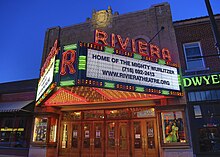
|
67 Webster Street | Added to the National Register of Historic Places, March 20, 1980 |
| 2 | Herschell Carrousel Factory Museum | 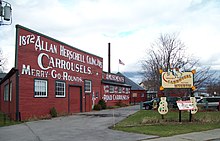
|
180 Thompson Street | Added to the National Register of Historic Places, April 18. 1985 |
| 3 | United States Post Office | 
|
141 Goundry Street | Added to the National Register of Historic Places, May 11, 1989 |
| 4 | Carnegie Library | 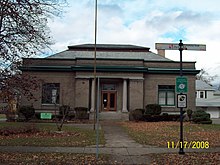
|
249 Goundry Street | Added to the National Register of Historic Places, July 14, 1995 |
| 5 | Dick Block | 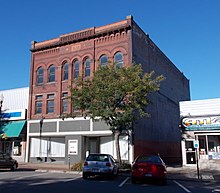
|
62 Webster Street | Added to the National Register of Historic Places, November 21, 2012 |
| 6 | Herschell–Spillman Motor Company Complex | 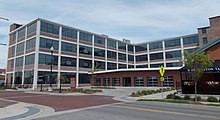
|
184 Sweeney Street | Added to the National Register of Historic Places, June 5, 2013 |
Demographics
| Census | Pop. | Note | %± |
|---|---|---|---|
| 1880 | 1,492 | — | |
| 1890 | 4,793 | 221.2% | |
| 1900 | 9,069 | 89.2% | |
| 1910 | 11,955 | 31.8% | |
| 1920 | 15,482 | 29.5% | |
| 1930 | 19,019 | 22.8% | |
| 1940 | 20,254 | 6.5% | |
| 1950 | 24,731 | 22.1% | |
| 1960 | 34,757 | 40.5% | |
| 1970 | 36,012 | 3.6% | |
| 1980 | 35,760 | −0.7% | |
| 1990 | 34,989 | −2.2% | |
| 2000 | 33,262 | −4.9% | |
| 2010 | 31,568 | −5.1% | |
| 2020 | 30,496 | −3.4% | |
| U.S. Decennial Census | |||
As of the census of 2000, there were 33,262 people, 13,671 households, and 8,981 families residing in the city. The population density was 3,293.2 inhabitants per square mile (1,271.5/km). There were 14,425 housing units at an average density of 1,428.2 per square mile (551.4/km). The racial makeup of the city was 97.86% White, 0.29% African American, 0.34% Native American, 0.53% Asian, 0.01% Pacific Islander, 0.29% from other races, and 0.68% from two or more races. Hispanic or Latino of any race were 1.09% of the population.
There were 13,671 households, out of which 30.2% had children under the age of 18 living with them, 50.8% were married couples living together, 11.1% had a female householder with no husband present, and 34.3% were non-families. 29.5% of all households were made up of individuals, and 12.8% had someone living alone who was 65 years of age or older. The average household size was 2.43 and the average family size was 3.03.
In the city, the population was spread out, with 23.7% under the age of 18, 8.6% from 18 to 24, 28.9% from 25 to 44, 23.1% from 45 to 64, and 15.6% who were 65 years of age or older. The median age was 38 years. For every 100 females, there were 94.6 males. For every 100 females age 18 and over, there were 90.6 males.
The median income for a household in the city was $39,154, and the median income for a family was $50,219. Males had a median income of $36,551 versus $25,129 for females. The per capita income for the city was $19,264. 7.2% of the population and 5.4% of families were below the poverty line. Out of the total people living in poverty, 9.1% are under the age of 18 and 6.1% are 65 or older.
Schools
The public schools of North Tonawanda are the North Tonawanda High School, North Tonawanda Middle School, Drake Elementary School, North Tonawanda Intermediate School, Spruce Elementary School, and Ohio Elementary School.
Essential services
- North Tonawanda City School District
- North Tonawanda Police Department
- North Tonawanda Public Library
- DeGraff Memorial Hospital, part of Kaleida Health
- North Tonawanda Fire Department (Combination Fire Dept); The department consist of 38 full-time career firefighters and volunteer firefighters from the Columbia Hook & Ladder Co. #1, Active Hose Co. #2, Live Hose Co. #4, Rescue Fire Co. #5, Gratwick Hose Co. #6, and the Sweeney Hose Co. #7. The NTFD has five stations and 6 apparatuses: 3 engines (Engine-4, Engine-6, and Engine-7); a ladder truck (Truck-1); a light rescue (Rescue-1); and a command car (Car-10). Staffing consists of four platoons (1-4).
Notable people
- Ted Barrett, MLB umpire
- Rudy Bozak, notable engineer
- Cindy Bradley, jazz trumpet player
- Jim Britton, retired MLB pitcher
- Rita Kogler Carver, studio designer
- Eugene de Kleist, organ builder
- Maryalice Demler, former Miss New York
- Tonio di Paolo, opera singer
- Ed Harmon, professional football player
- Bret Hoffmann, death metal vocalist
- Jim Hurtubise, automobile racer
- Edward C. Kuhn, U.S. military coat of arms designer
- William Larson, photographer
- Robert Mangold, artist
- George D. Maziarz, politician
- Bernard Joseph McLaughlin, Auxiliary Bishop of Buffalo Diocese
- Hans Oldag, German-born American long-distance runner
- Jamin Olivencia, professional wrestler
- John Olszowka, historian
- Robert G. Ortt, politician
- Gladys Parker, comic strip artist
- Lewis S. Payne, former New York State Senator
- Roman Piskor, NFL football player
- James Rand Jr., industrialist
- Stan Rojek, major-league baseball player
- Geoff Sanderson, former NHL player
- Paul Schaus, sledge hockey gold medalist
- Robin Schimminger, politician.
- Don Smith, Olympic rower
- Henry P. Smith III, politician
- Paul Van Arsdale, hammered dulcimer player
- Christopher J. Waild, screenwriter
- Andy Williams, guitarist in Every Time I Die
- Phil Fasciana (Death Metal Guitarist)
See also
References
- "ArcGIS REST Services Directory". United States Census Bureau. Retrieved September 20, 2022.
- ^ North Tonawanda History Museum ©
- Carrousel Factory Museum
- ^ Smyczynski, Christine A. (2005), "Western New York: From Niagara Falls and Southern Ontario to the Western Edge of the Finger Lakes". pp 93-99, 101-102. The Countryman Press: Woodstock, Vermont.
- "US Gazetteer files: 2010, 2000, and 1990". United States Census Bureau. February 12, 2011. Retrieved April 23, 2011.
- "NowData – NOAA Online Weather Data". National Oceanic and Atmospheric Administration. Retrieved May 1, 2021.
- "Summary of Monthly Normals 1991–2020". Retrieved May 4, 2021.
- "National Register Information System". National Register of Historic Places. National Park Service. April 15, 2008.
- "National Register of Historic Places". Weekly List of Actions Taken on Properties: 12/03/12 through 12/07/12. National Park Service. December 14, 2012.
- "National Register of Historic Places". Weekly List of Actions Taken on Properties: 6/17/13 through 6/21/13. National Park Service. June 28, 2013.
- "Census of Population and Housing". Census.gov. Retrieved June 4, 2015.
- "U.S. Census website". United States Census Bureau. Retrieved January 31, 2008.
- North Tonawanda High School / Overview
- North Tonawanda Middle School / Overview
- Drake Elementary School / Overview
- North Tonawanda Intermediate School / Overview
- Spruce Elementary School / Overview
- Ohio Elementary School / Overview
External links
| Municipalities and communities of Niagara County, New York, United States | ||
|---|---|---|
| County seat: Lockport | ||
| Cities | 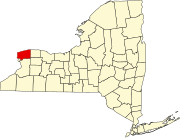 | |
| Towns | ||
| Villages | ||
| CDPs | ||
| Other hamlets |
| |
| Indian reservations | ||
| Footnotes | ‡This populated place also has portions in an adjacent county or counties | |
| Buffalo–Niagara Falls metropolitan area | ||
|---|---|---|
| Principal city |  | |
| Other major cities | ||
| Counties | ||
